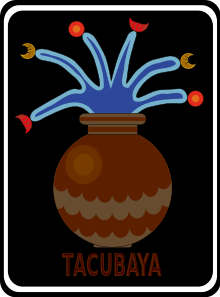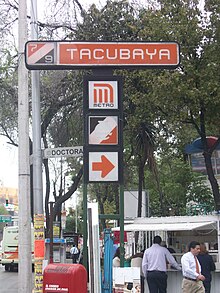Tacubaya
This prehistoric settlement eventually divided into a ceremonial center in the north and housing in the south, showing signs of influence from the Teotihuacan culture.
Tacubaya consisted of wide, flat land and had free flowing rivers that supplied fresh water to Mexico City.
Moving the capital of New Spain from Mexico City (now the historic center) to Tacubaya was considered early in the colonial period but it never happened.
[10] After the end of the Mexican War of Independence in the 19th century, Tacubaya remained a popular getaway for the wealthy.
The creation of the Departmento del Distrito Federal eliminated the municipal government structure here, and integrated the area politically with the city.
[4] In the early 20th century, the first tall structure of the Mexico City area was built here, called the Ermita Conjunto or Triángulo de Tacubaya, which was at the vanguard architecturally at the time in Art Deco style.
The stately mansions that line the sides of the Alameda and used to house the political and intellectual elite now sit among garbage, alcoholics and drug trafficking.
Residents want the federal agency INAH to intervene to protect buildings such as the Justo Sierra House, now a primary school, and the Parish of La Candelaria, which is over 450 years old.
[11] The borough of Miguel Hidalgo has established a “consejo ciudadano” or citizen’s council to allow public participation in the “Renace” Project.
The goals are to work on issues such as peddlers, shootings, pothole repair, crime and the maintenance of historic buildings.
[12] The Alameda Tacubaya Park is located on Avenida Revolución, between Parque Lira and José María Vigil.
When this neighborhood was at its height, the park was surrounded by mansions with large gardens, where the political and intellectual classes had country homes.
Today the area is very much deteriorated, with the park inhabited by alcoholics and drug addicts, surrounded by garbage.
[13] Barragán was a major figure in Mexican culture, whose works have served to influence architects to the present day.
[13] The house in Tacubaya stands out in part due to its use of wood and stone, roofs held up with large beams and with tones of white, rose and yellow dominating.
It was later owned by a number of wealthy families, before passing back into the hands of the government, which made it a juvenile detention facility.
[13] The Ermita Building is considered an important example of Art Deco architecture and was the first high rise to be constructed in the Mexico City area.
The side facades also have plaques on the face, balconies and pilasters decorated in metal which define the movie theater area.
The neighborhood was always poor, first inhabited about 100 years ago when small houses of adobe with wood roofs were built, forming the narrow streets that are found here.
The area is filled with garbage and the smell of urine and stagnant water from drains that no longer work.
[16] Neighbors say that most of the people in the lost city are transvestites, drug addicts, thieves as well as entire families, of which there are an estimated hundred.
There are 18 lanes total on the main roads here (Revolución, Viaducto, Benjamin Franklin and Parque Lira streets) but generally 13 of them are blocked by buses and other public transport.










